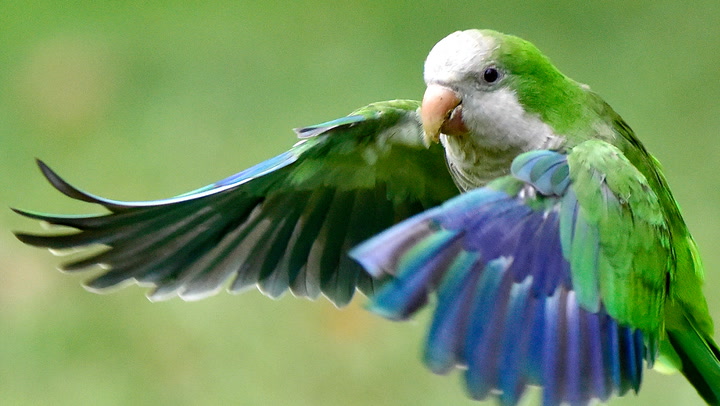Unveiling the Monk Parakeet (Quaker Parrot): A Closer Look
The Monk Parakeet, also known as the Quaker Parrot, is a charming and distinctive member of the parrot family known for its unique appearance and sociable nature. In this comprehensive exploration, we will delve into the captivating world of the Monk Parakeet, from its distinctive characteristics to its historical discovery.
The Monk Parakeet is scientifically known as Myiopsitta Monachus. Its common name, “Monk Parakeet,” is derived from its distinctive gray facial markings, which resemble the attire worn by Quaker religious leaders. This parrot species exhibits a striking combination of bright green plumage, a gray forehead, and a long, pointed tail.
The Quaker Parrot was first documented by European explorers in the 18th century during their journeys to South America, particularly in the regions of Argentina and surrounding areas. The parrot’s captivating appearance, coupled with its lively and engaging personality, quickly captured the attention and admiration of naturalists and avian enthusiasts alike.
Habitat and Range: The Monk Parakeet (Quaker Parrot)’s Natural Home
Monk Parakeets are native to the countries of South America, including Argentina, Bolivia, Brazil, and Uruguay. These parrots have adapted to a variety of habitats, with a preference for open woodlands, savannas, and agricultural areas. Their natural range extends across a broad swath of South America, reflecting their ability to thrive in different ecosystems.
One of the most notable characteristics of the Monk Parakeet is its remarkable nesting behavior. Unlike most parrot species that nest in tree hollows, Monk Parakeets build intricate communal nests in trees or artificial structures. These communal nests are often a network of interconnected chambers, each occupied by a mated pair or family group. The cooperative construction and maintenance of these nests are one of the species’ distinguishing features.
Inside the Monk Parakeet (Quaker Parrot)’s World: Personality and Behavior
Monk Parakeets are celebrated not only for their striking appearance but also for their engaging personalities and social behaviors. These birds are known for their strong social bonds, both within their family groups and with their human caregivers.
One of the most remarkable aspects of Monk Parakeet behavior is their propensity for forming tight-knit communities. In the wild, they often congregate in large flocks, engaging in communal activities such as foraging, grooming, and vocal exchanges. This cooperative behavior extends to their nesting habits, with multiple pairs working together to construct and maintain their shared nests.
As pets, Monk Parakeets readily bond with their human caregivers, forming affectionate and often talkative relationships. They are known for their ability to mimic human speech and a wide range of sounds, which adds to their appeal as companion birds. Their playful nature and inquisitive disposition make them engaging and interactive pets.
A Glimpse into the Monk Parakeet (Quaker Parrot) Diet
Monk Parakeets are primarily herbivorous, with a diet that includes a variety of seeds, fruits, vegetables, and green vegetation. In their native habitat, they forage for food sources such as seeds, grains, and fruits from a wide range of plants.
In captivity, replicating their natural diet is essential for their health and well-being. High-quality commercial parrot pellets designed for their species serve as a base, supplemented with fresh fruits and vegetables. Providing a diverse array of food options helps ensure proper nutrition and enrichment.
Fresh water should always be available, as hydration is crucial for their health and vitality.
Symphony of Chirps: Understanding Monk Parakeet (Quaker Parrot) Vocalizations
Monk Parakeets are known for their vocal talents, producing a wide range of vocalizations, including chirps, squawks, and chatters. Their vocal repertoire serves various purposes, both in the wild and as pets.
In the wild, Monk Parakeets use vocalizations to communicate with their flock members, signaling alarm at potential threats, coordinating activities such as foraging, and maintaining social bonds. These vocal exchanges are integral to their daily lives and play a significant role in their interactions.
As pets, Monk Parakeets are known for their ability to mimic human speech and a variety of sounds from their environment. They often develop a vocabulary of words and phrases and can be quite talkative and engaging. Their vocalizations add to their charm as beloved companions.
Monk Parakeet (Quaker Parrot) Populations: In the Wild and Beyond
The conservation status of Monk Parakeets varies depending on the region and the specific species. Some populations are stable and not considered threatened, while others face challenges such as habitat loss and illegal trade.
Efforts are underway to protect and conserve Monk Parakeets in the wild. Conservation initiatives focus on preserving their natural habitats, monitoring populations, and raising awareness about the importance of these parrots in the ecosystems they inhabit.
As pets, Monk Parakeets are cherished for their affectionate nature and vocal abilities. Ethical practices in breeding and ownership are essential to ensure their well-being and prevent harm to wild populations.
Conclusion
Monk Parakeets, with their distinctive appearance, cooperative nesting behavior, engaging personalities, and captivating vocalizations, have carved a unique niche in both the natural world and the hearts of humans. Their native habitats in South America showcase the rich biodiversity of these regions. If you have any specific questions then please consider joining and posting in one of our following bird groups:
As we navigate the challenges of habitat loss and conservation, it is our shared responsibility to protect and preserve the habitats and populations of these remarkable parrots. Whether observed in their native homes or cherished as beloved companions, Monk Parakeets serve as a testament to the beauty and brilliance of the avian world, reminding us of the importance of conservation and the wonders of our planet’s diverse ecosystems.

